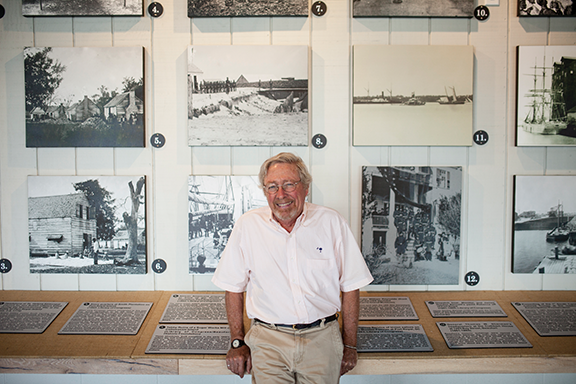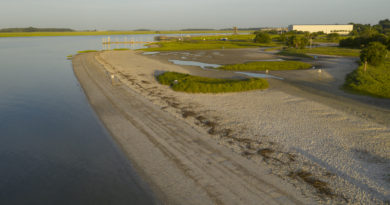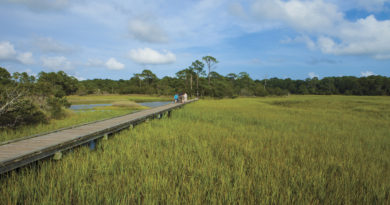The Port Royal Sound Foundation: A Sound Vision
story by Carol Lauvray
photography by john wollwerth
If you live in the Port Royal Sound Area or visit here, you know the attraction of this pristine coastal masterpiece, teeming with a rich and diverse ecosystem of plant and animal life. Water surrounds you literally everywhere you go in Beaufort County. Seeing dolphins swimming in the river, oysters peaking out of the pluff mud at low tide, and vast expanses of Spartina grass swaying in the marshes, are everyday blessings here. It’s no wonder that locals have been actively seeking to protect this unique natural paradise since the late 1960s, when plans were first announced to build a chemical plant within the Sound.
The Port Royal Sound Foundation and its Mission
In 2001, the Friends of the Rivers formed as a stewardship group with the mission of water quality protection and land planning. After a decade of promoting the importance of protecting the marine waters of Beaufort County, the group evolved into the Port Royal Sound Foundation. The Foundation formed in 2011 as a 501(c)(3) nonprofit organization, with its mission being “to advance the awareness of Port Royal Sound and its contributions to the environmental, cultural, and economic well-being of our area, the region and the Atlantic Ocean.”
Dean Moss, Chairman of the Foundation’s Board of Trustees, has been actively involved in water and land conservation activities here since moving to Beaufort 30 years ago. “The Port Royal Sound Foundation originated from the idea that protecting the Sound as a completely unique and virtually pristine body of water, along with managing land development and growth, is crucial to preserving the area’s history, culture and natural resources,” he says.
The rivers and creeks in this area are tidal (influenced by the rise and fall of the Atlantic Ocean), but they are also affected by what happens in the Port Royal Sound Drainage Area, which extends into the surrounding counties. Potential hazards to the Port Royal Sound ecosystem include runoff water from many sources—even rainfall can affect the salinity level of the marine waters and can be harmful to the area’s salt marshes. In addition, fresh water runoff can carry pollutants like pesticides, fertilizers, metals, chemicals, litter and yard and pet waste into the creeks and rivers, adversely affecting the waters of the Sound, along with the plants and animals that live in and around it.
Moss emphasizes that the Foundation’s vision is not only to conserve the environment of the Port Royal Sound, it also extends to educating people about the area’s natural resources, history and culture, encouraging research pertaining to the Sound, and promoting the recreational aspects of the Sound, such as fishing and boating. To realize its vision, the Foundation has formed strategic partnerships with many organizations including: LowCountry Institute; Waddell Mariculture Center; SC Department of Natural Resources; University of South Carolina—Beaufort; Beaufort County Open Land Trust; Wardle Family YMCA; Spirit of America Foundation—Premier Youth Boating Safety Education; and Beaufort County Schools.
He also credits local businessman, entrepreneur, and fellow Foundation Board Member, Dick Stewart, with recognizing and promoting many opportunities for the Foundation to achieve its objectives. Moss explained that at the Foundation’s first board meeting in 2011, Stewart announced to the other trustees that he would donate the land and building, where the Port Royal Sound Maritime Center now stands, to be used as the Foundation’s education center.
The Port Royal Sound Foundation Maritime Center
The Center’s Roots
The Maritime Center opened its doors to the public in November 2014. It’s housed in the former Lemon Island Marina on the Chechessee River between Beaufort and Bluffton on Highway 170, and was once the site of a seafood processing operation. “It’s a great location in the middle of Beaufort County, overlooking the waters of the Port Royal Sound,” Moss emphasized.
The Center’s evolution from what he terms a “dilapidated but iconic” waterfront building to it’s current state required an extensive renovation that spanned more than a year and cost $2 million, with nearly all of the funding coming from private donations, along with some accommodations tax money from Beaufort County. To help secure the needed money and donations of goods and services, Moss says the Foundation’s board held receptions for folks in communities like Habersham, Spring Island, Callawassie Island, Dataw Island and Oldfield to educate them about the Foundation’s mission and plans. Corporate donors included Montgomery Architecture & Planning, Beaufort Construction, DuPriest Construction Company and Hilton Head Glidden.
Fun and Learning on the Sound
When you visit the Maritime Center, you’ll be treated to a panoramic view of the Chechessee River, with its salt marshes, oyster beds and mud flats. Inside the Center are exhibits featuring Port Royal Sound’s history and ecology, including a 3,000-gallon salt-water aquarium displaying fish that live in the waters of the Sound. In another room, shallow touch tanks showcase local marine life and provide a hands-on experience for “kids” of all ages.
In the main exhibit hall, you’ll see a Predator Diorama hanging from the ceiling. Also overhead is a model of a gigantic Megalodon jaw, illustrating just how huge the prehistoric shark was. Additional exhibits educate visitors about the Moon and Tides, the Sharks of Port Royal Sound and Underwater Sounds. There’s also a History Wall sponsored by Beaufort County and a life-size model of Snowball, the Sound’s famous albino dolphin.
A new long-term exhibit made possible by a grant from Women In Philanthropy, a fund of Community Foundation of the Lowcountry, is now in the works and will open in June, according to Jody Hayward, Executive Director of the Maritime Center. She says the exhibit, How can you help protect the Port Royal Sound?, will continuously evolve and provide information like the following: “It’s estimated that 35 billion plastic water bottles are used each year in the US and it takes 450 years for a water bottle to decompose! Let’s keep them out of the Port Royal Sound!”
The Maritime Center also features new temporary exhibits every two months in its Habersham Rotating Exhibit Room. The Spanish Moss Trail and Beaufort Open Land Trust are currently showcased. “They both have such wonderful missions and are a huge asset to our community,” says Hayward. “We enjoy being able to highlight organizations whose missions are influenced by the Port Royal Sound. The Maritime Center highlights not only the ecological aspects of the Sound, but also the artistic, cultural, historic and recreational.”
Educational and recreational programs sponsored by the Maritime Center include: birding, fly fishing, eco boat excursions, kayak tours, activities for preschoolers and toddlers, and a classroom series led by area experts on a variety of topics related to the Sound. The Center’s staff includes two Naturalists who coordinate its programs and educational efforts. The Center relies on volunteers to greet visitors and answer questions, and to maintain its aquarium and touch tanks.
More than 15,000 people visited the Maritime Center in 2015, and the number of visitors in 2016 is running significantly ahead of the same period last year, according to Hayward. She says nearly half of the Center’s visitors are tourists and that percentage is steadily climbing.
What’s in the Future for the Port Royal Sound Foundation?
Fundraising is important to sustaining any nonprofit organization. Moss says that the challenge for the future is how to pay to operate the Port Royal Sound Foundation, its Maritime Center and its initiatives. He explains that sources of funds include grants and some very generous donors, however, the organization cannot run on donations alone. To pay for its operations, the Foundation holds four major fundraising events annually, including Night On The Sound, which will be held October 22nd this year and will feature famed National Geographic Explorer, Dr. Robert Ballard. It also leases the Maritime Center to other organizations for events, as well as leasing space on its docks to fishing guides and kayak tour operators. As Board Chairman, Moss says his primary focus is developing a sustainable business model that will produce the $500,000 to $600,000 in annual operating funds needed to support the Foundation and the Maritime Center.
“As an organization, the Foundation is evolving and we are seeing a lot of opportunities arising,” says Moss. A case in point is a deal now in the works that would allow the Beaufort County Rural and Critical Lands Program and the Port Royal Sound Foundation to purchase the 95-acre tract of land directly across from the Maritime Center. He says that the bulk of the land would remain undeveloped and be conserved, however 10 acres would belong exclusively to the Foundation. Future use of that land could include such things as education, labs for research, dorms for interns and recreation, he says.
Regarding the Port Royal Sound Foundation’s opportunities in the future, Moss says, “It’s kind of like the sky’s the limit!”




